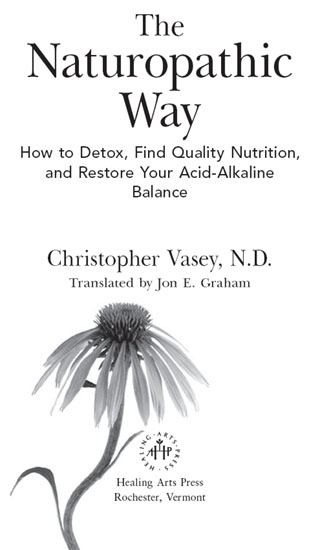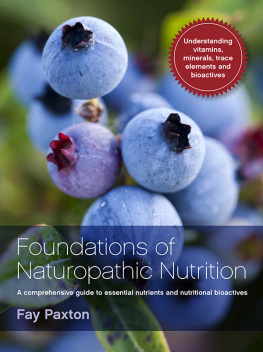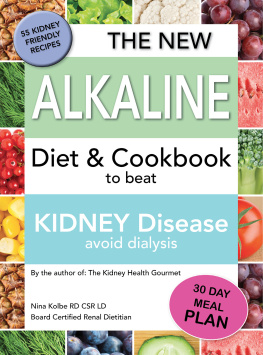
Contents

Chapter 1
Chapter 2
Chapter 3

Foreword

Our medical system is ill, and Western society, like the rest of our planet, is not faring well. Iatrogenic illnesses (illnesses actually caused by allopathic treatments) and nosocomial illnesses (those that develop in hospitals) are increasing at an alarming rate. We promise the children being born today that they will live to see one hundred, but we are confusing medicated old age with an enjoyable quality of life.
At the same time, its been demonstrated that 90 percent of all cancers are linked to nutritional and environmental factors. Doctors are developing more and more cases of depression in the two years following establishment of their professional practices.
Should our response to these paradoxes of the modern world be to maintain our comfort level with an ostrichlike denial of the evidence, or to hold an alarmist and paranoid discourse? Naturopathy believes that this picture, dramatic as it may be, can be studied calmly and solved positively if we can manage to awaken the awareness of both consumers and decision makers, most of whose views have been framed by a single philosophy.
In fact, whether it involves ecoplanetary or health imbalances, everything rests on the philosophy, points of reference, and points of view that determine human behavior. Most of the problems we currently face have their origin in materialistic thinking and the egotistical belief that humanity can operate independently of the laws of nature or biology.
Naturopathys chosen objective is health and well-being, but in the framework of a profound and authentic reconciliation with these laws, which are often simple and full of common sense: How do we best nourish ourselves, breathe freely, and take care of our bodies and their natural elimination processes? How do we optimize our sleep, our vitality, and our libido? How do we recharge ourselves through the natural elementsearth, water, air, and light, for example? Why should we carefully alternate times of activity and times of rest? How can we purify and regenerate the internal cellular environment of our bodies? How can we be consumers without endangering our planetary resources?
Good sense such as this is to be found, in fact, where it has always been: in the heart of the great health-sustaining recommendations and medical traditions that date back to the fabled teachings of the Sumerians and the Essenes. This includes Ayurvedic, Native American, Chinese, and Tibetan practices, and more specifically for us in the Western world, Hippocrates noble philosophy. The most surprising thing, perhaps, is that beyond the contextual differences in their details, all of these traditions are based on the same foundations, and only allopathic medicine (the institutional Western form that prevails in most of the world today) has been established in total opposition to these universal concepts.
What, then, are the common elements in these traditions? Prevention is preferable to healing, teaching is preferable to treating, and giving the individual responsibility for his or her health is preferable to taking charge. Other common features include considering the whole person rather than the symptom, remaining humbly and respectfully attuned to the laws of a healthy life, and working with the energetic processes of regeneration and spontaneous self-healing rather than putting your faith in the effectiveness of a remedy. In short, an entire program.
After more than a century in the United States and seventy years in Europe, naturopathy has become the discipline that offers another kind of medicine, one in which the practitioner is first and foremost an educator of health, perfectly effective in the treatment of all the chronic diseasesthe so-called functional diseasesas well as in primary prevention and quality of life. This does not make the naturopath just one more practitioner in the vast field of natural medicine that includes, for example, phytotherapy and homeopathy. He remains, rather, the general practitioner of health, as the allopathic physician is the general practitioner of illness. Is it now possible to envision the ideal public health systemperhaps modeled after the integrated medicine practiced in some parts of the United Statesin which the allopathic doctor, the natural medicine practitioner, and the naturopath can congenially complement one anothers services in an atmosphere of perfect mutual respect, all for the benefit of the patient?
The French Federation of Naturopathy (FENAHMAN) states that naturopathy is founded on the principle of the vital energy of the body, and that it combines the practices that have emerged from Western tradition based on the ten natural aspects of health: diet, hydration, psychology, physical exercise, respiration, plants, reflexology, light therapy, and manual and energetic techniques. It aims at preserving and optimizing the overall health and quality of life of an individual by allowing the body to regenerate itself through natural means. Faithful to these concepts, my colleague Christopher Vasey has realized a work of remarkable synthesis here, because it is no easy task to summarize the essence of our art, as well as its useful application, in so few pages. Hes earned my great respect for his precision, and my sincerest congratulations for his teaching ability.
In this work, we have the pleasure of rediscovering the essential keys of the five columns treasured by Hippocrates and all of our European teachers (Sebastian Kneipp, Paul Carton, Henri Durville, Pierre Valentin Marchesseau, Andr Roux), and North American teachers (Benedict Lust, John H. Tilden, Henry Lindlahr, Bernarr Macfadden, Bernard Jensen), namely: serology, the science of bodily fluids and their disorders (excesses, deficiencies, obstructions); vitalism, the study of our intrinsic vital energy and its invaluable capabilities (homeostasis, regeneration, self-healing); prevention, maintaining our connection with the natural world and a wholesome lifestyle; causalism, the methodical quest for the primary origin of symptoms, which always comes back to not only the condition of the bodily fluids, but also the energetic state, meaning psychology, spirituality, or ecology; and holism, the global approach to the human being and the way he interacts with his environment.
Thank you, Christopher, for this new reference work, and pleasant reading to all.
DANIEL KIEFFER
Daniel Kieffer is the president of FENAHMAN, which is the French Federation of Naturopathy, and president of the UEN, the European Union of Naturopathy. He is also the director of CENATHO, the European College of Traditional Holistic Naturopathy, and a member of OMNES, which is the Organization of Natural Medicine and Health Education.
Introduction

For many people, naturopathy distinguishes itself from allopathic medicine only by the remedies it employs. These remedies are natural (found in naturemedicinal plants, hydrotherapy, and so forth) rather than chemical (created in a laboratory). In reality there is another stark difference: the naturopath has a completely different concept of disease from that of the allopathic physician.
Naturopathy, therefore, does not do the same thing by different means, but actually does something quite different, using extremely dissimilar means. Its therapeutic objectives are, in fact, governed by a completely different logic.
Next page





